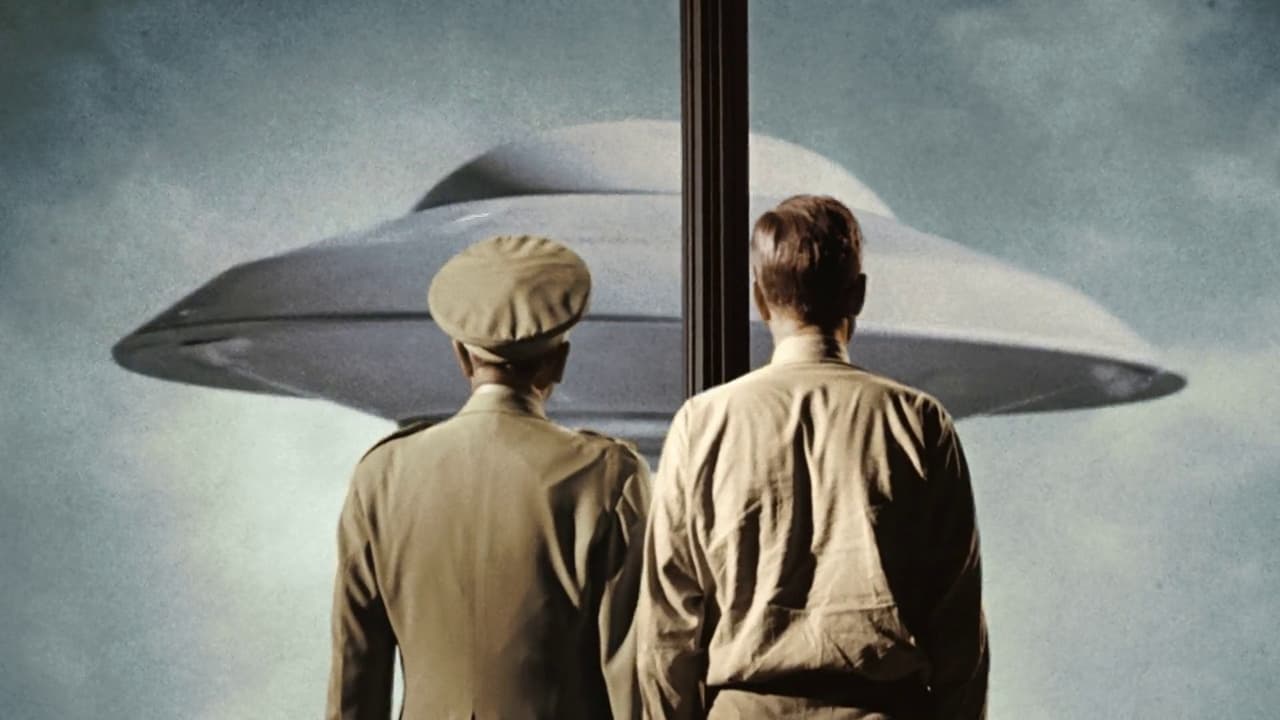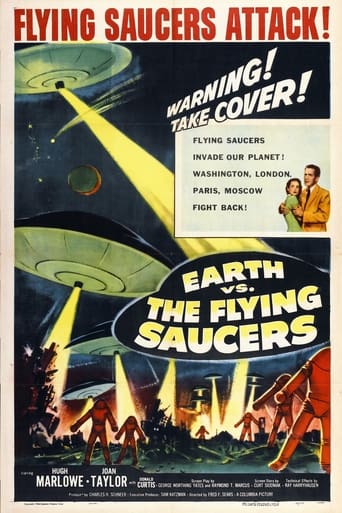

Studly Hugh Marlowe ("The Day the Earth Stood Still") is the egghead hero of this classic example of alien invasion sci-fi. He plays scientist Russell Marvin, one of the first few humans to witness extraterrestrial craft in our own atmosphere. It turns out, the creatures are here to colonize our planet - hopefully with our consent, but it's no skin off their "noses" if we don't go with the program. They have advanced weaponry to use against mankind, but they didn't count on Russells' ingenuity."Earth vs. the Flying Saucers" is pretty good for a movie of this nature. As was often the case with movies of its ilk, it features a narrator who gives the proceedings a documentary type of approach. It's a reasonably intelligent story (scripted by Bernard Gordon and George Worthing Yates), with an array of engaging characters. Less patient viewers could make the point that it's often more plot and dialogue-based than action-oriented, but it does work its steady way towards some effective scenes of destruction and annihilation. The special effects are fine, but it's the "technical effects" devised by stop-motion legend Ray Harryhausen that do ultimately take centre stage. Fred F. Sears, whose other B credits during this era include "The Giant Claw" and "The Werewolf", capably occupies the directors' chair.Marlowe, and the very pretty Joan Taylor (also the leading lady in "20 Million Miles to Earth"), are a hero and heroine for whom we can easily root; he possesses a Richard Carlson-like air of sincerity. Donald Curtis ("It Came from Beneath the Sea") is the efficient Major Huglin. Of course, you can't go wrong with character actor Morris Ankrum ("Rocketship X-M") in a key supporting role; he was on hand for a number of these 50s sci-fi flicks, and was always excellent value. John Zaremba ('The Time Tunnel'), Thomas Browne Henry ("Beginning of the End"), Grandon Rhodes ("Detective Story"), Larry J. Blake ("Creature with the Atom Brain"), Clark Howat ("Billy Jack"), and Harry Lauter ("Escape from the Planet of the Apes") co-star, and the great Paul Frees - actor, author, composer, songwriter, and prolific voice-over artist - performs the voice of the alien intelligence.Good fun, and essential for anybody who enjoys this sort of entertainment; subsequent blockbusters like "Independence Day" may outdo it for sheer spectacle, but this movie isn't nearly as stupid as that one.Seven out of 10.
... View MoreThis is a sci fi movie for the following reasons: 1. At 34.35 when Maj.Huglin runs after Dr.Marvin, Mrs.Marvin was ready to jump into the car, dressed with her overcoat on, while a few seconds before she was in bed in her pijama. I wish my wife could do that! In 33 years of marriage I have to wait at least half an hour to get her ready.2. Dr. Marvin is always perfectly shaved even when he and his wife are stuck in the soundproofed room in the bunker. The other character are perfectly shaved, and even General Hanley zombified by aliens, too. Female character's make up is always perfect, when she just woke up and even when she is sleeping!3. Eyewitnesses are never not believed by military. Not just any Mr.Smith, but the director of the Sky Hook project!4. Military shoot their pathetic bullets against energy shields flying saucers also after they have seen with their eyes that UFOs have disintegrator rays.5. Revolutionary deadly weapon against invaders from outer space is ready in a couple of weeks and it works perfectly from tracks in Washington. Even if alien invaders have threated all the superpowers in the world (and we suppose that hundreds of UFOs are attacking the main cities of the world), half a dozen flying saucers down in US capital are enough to save the world.Please notice the amazing Independence Day quotes 40 years in advance! Actually I gave Independence Day even less score because you CAN'T program a virus for an alien operating system and need to shoot it physically into the alien starship causing their defeat. Just you CAN'T. Sci fi has some rules you know...Special effects are the best thing in the movie. The script looks like they wrote it in a lazy afternoon. Still it has some improvement with respect to the War Of The Worlds (1953): you can actually see and hear the aliens. Aliens are vulnerable. A rifle does kill them. We know why they are here.Anyway nothing to do with the great The Day the Earth Stood Still (1951), (Italian "Ultimatum To The Earth" is a better title, I think)Is deserves a watch, but remember that The Forbidden Planet (same year, 1956) is far beyond this average, forgettable movie.Hope this can be useful.
... View MorePretty hokey to be sure. Some of my favorite parts are when they are driving in their cars...no seat belts, fake backgrounds as they drive through streets, not watching the road while driving at high speeds. Also, after seeing that the big guns didn't shoot through the saucers force field, the foot soldiers decide to shoot the rifles at the saucer. Pretty hokey, but entertaining for sure.
... View MoreIt's a pretty standard 50's sci-fi film made in response to the rash of UFO sightings that began in that era and that continues to this day. It's not the best movie about alien invasions of earth - not the best even from that era. That honour would probably belong to 1953's "The War Of The Worlds" or perhaps "The Day The Earth Stood Still" from 1951. This movie has all the limitations of the era - extremely primitive effects being the primary one. Neither the flying saucers nor the buildings they crashed into looked particularly convincing and there were some holes in logic and in science, but at the same time it was an entertaining enough movie that sought to whip up people's fears about the phenomenon.Here the flying saucers are the remnants of a dying civilization looking for a planet to be their new home, and seeking to take over the earth. Starting with a series of satellite launches that failed (one wonders why they kept launching 11 of them when they kept losing contact with them soon after launch) it ends with a pretty good battle between earth and the flying saucers (the title being a pretty good summary of the content of the movie; although "earth" in this case was represented almost totally by the United States.) Overall, this featured pretty good performances for a B movie of the era, and while not the best movie of its kind, it was nevertheless pretty good. (5/10)
... View More